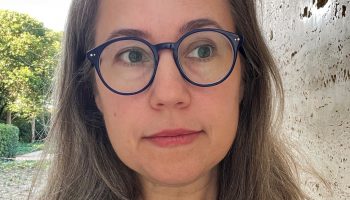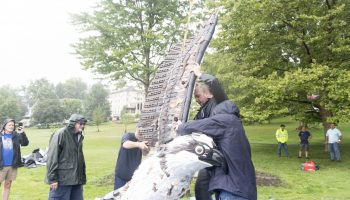As it turns out, wherever the achievements and perspectives of those who account for at least 50 percent of the population — women — are not publicly documented, they are also marginalized and minimized by organizations that purport to objectively chronicle the historical developments and viewpoints of those populations as a whole.

Even during the year commemorating the women’s vote centennial in the United States, male voices typically transcend female voices; his story supersedes her story.
In Pittsburgh, Leslie Przybylek, senior curator at the Senator John Heinz History Center, is working to lessen this gender disparity.
Przybylek’s Contemporary Issues Forum lecture — titled “A Woman’s Place IS IN THE Exhibition” and sponsored by the Chautauqua Women’s Club — will be presented at 3:30 p.m. EDT on Tuesday, Aug. 4, on the CHQ Assembly Video Platform. It will be followed by a live Q-and-A session.
At the Heinz History Center, Przybylek has been exploring connections between national events and regional history and identity. Her CIF talk is an extension of her work for the most recent exhibition, “Smithsonian’s Portraits of Pittsburgh: Works from the National Portrait Gallery.”
Since becoming the center’s senior curator in 2013, she has also been transforming her research on forgotten chapters of history — including 19th- and 20th-century popular culture, technology, and foodways — into major exhibitions, such as: “We Can Do It! WWII,” “Pittsburgh’s Lost Steamboat,” and “Pennsylvania’s Civil War.”
“I am from western Pennsylvania,” Przybylek said. “My parents, on both sides, are from Pittsburgh through and through. I grew up in Crawford County, about an hour south of Erie in Northwestern Pennsylvania. I spent about 16 years after graduate school out of the area before I came back in 2013.”
A childhood fascination with Pittsburgh’s Carnegie Museum of Natural History, to which her grandparents introduced her, sparked an early interest in museums. Famous since 1899 for its dinosaur collection, the museum houses the world’s largest collection of Jurassic-age dinosaurs. She said that she and her father loved the dioramas of dinosaurs and fish.
A Phi Beta Kappa graduate of Gettysburg College, founded in 1832, Przybylek studied art, art history and the performing arts. This southern Pennsylvania campus is located adjacent to Gettysburg National Military Park, and includes the Gettysburg Battlefield.
“I became very fascinated with how visitors and (the community) interacted with the Civil War and reacted to Civil War history,” she said.
Upon graduation, Przybylek spent nine months working at the interactive, hands-on Children’s Museum of Pittsburgh before continuing her academic studies in art history at the University of Delaware, which she said was one of the institutions that founded American art history.
After doing some interim teaching, Przybylek spent a few years in Crawford County at Meadville’s Baldwin-Reynolds House Museum.
Seeking “something new to shake things up,” she then moved to Arkansas’s second-largest city, Fort Smith, at the confluence of the Arkansas and Poteau rivers and the far western edge of the state, bordering Oklahoma. Founded in 1817 as a military post, it became a base for the settling of the “Wild West” and for law enforcement.
Native American Indian and migrant cultures clashed at Fort Smith, and Judge Isaac C. Parker — better known as the “Hanging Judge” — served as U.S. District Judge and had jurisdiction over Indian Territory from 1875 to 1896. The story of the fictional character “Rooster” Cogburn in Charles Portis’ novel True Grit relates to Parker’s life.
At Fort Smith, where the National Park Service preserves nearly 80 years of history at Fort Smith National Historic Site, Przybylek said she examined the federal court, its executions, and the culture. She was also responsible for collecting and mentorship projects through the Mount Magazine Chapter of the Girl Scouts and Girl Scouts, Inc. There she “had creative free range within a shoestring budget.”
“From there I went to Kansas City, Missouri and took a job at an NEH (National Endowment of the Humanities) regional Mid-America Arts Alliance,” Przybylek said. “They were still in the process of getting some of the (Crossroads) Arts District in progress. (Kansas City) has a great independent arts scene. … The alliance worked in a large area including Arkansas, Oklahoma, Texas, Kansas, Missouri and Nebraska.”
Managing the national exhibits program NEH on the Road, and developing and assembling five to six exhibits at a time in Kansas City, Przybylek engaged “small and mid-size museums across the country with NEH-funded humanities scholarship” as Curator of Humanities Exhibitions with Mid-America Arts Alliance.
She said that one of her exhibitions featured cowgirls. Another — a personal favorite — showcased African American basket-makers in South Carolina.
In January 2013, Przybylek returned to Pittsburgh and began her position as senior curator at the Heinz History Center.
“As a public historian, I deal with the nuts and bolts of how to use … things,” she said. “… I’m one of the people who help determine the storyline and approaches. How do I take the materials — photos, images, (newspaper research) — and … frame that story, especially when talking about women, and give them a presence? … How do I take them and map out a storyboard? … How do the objects then represent the story?”
“You have to have a beginning and an end,” Przybylek continued. “The artifacts are like actors on a stage. Here’s a piece put on the wall. How do (the pieces) interact with each other in a three-dimensional space?”
At the Heinz History Center, she has been getting back to the kinds of projects she engaged in at Fort Smith, but with a larger budget. And as she did in Kansas City, she is taking regional stories and adding in the national perspective.
For instance, in the center’s project with the National Portrait Gallery, Przybylek said that they went into the gallery’s collection with a Northwestern Pennsylvania perspective. In working directly with lenders and with traveling exhibitions, everything is localized.
Regarding women in exhibitions, Przybylek said: “A lot of people will say that there’s been so much progress. And yet, it’s not always easy from the micro view — the curator’s view — (getting) women into an exhibit. Here is the upcoming 19th Amendment (centennial) of women’s suffrage, but we still have problems looking at it from the nuts and bolts angle of how do you actually use it in the gallery.”




